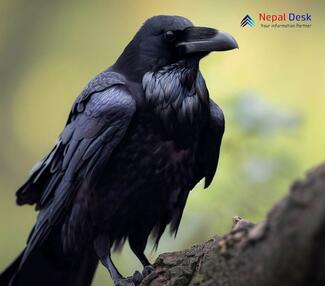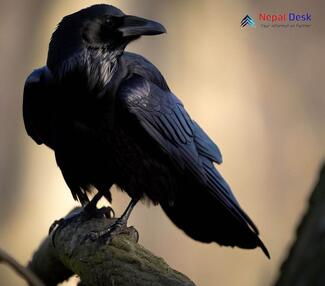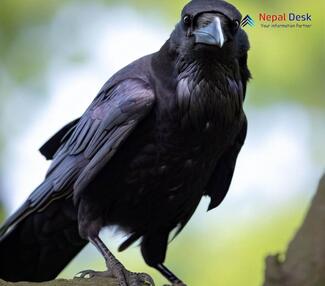The Common Raven (Corvus corax) is a large, intelligent corvid species with an expansive distribution across the Northern Hemisphere. With its slick black feathers and distinctive wedge-shaped tail, deep croaking vocalizations, and adaptable foraging behaviors, this resourceful bird plays integral ecological roles across diverse ecosystems.
Occupying areas from Arctic tundra to deserts and forests to cities, the Common Raven's wide habitat tolerance, mobility, and longevity underpin its status as the world’s most widely distributed passerine. Populations are widespread and substantial, numbering tens of millions globally.
In Nepal, the Common Raven is a familiar year-round resident of rural villages as well as uninhabited mountain landscapes up to 5000 m in elevation. Opportunistic and adaptable, Nepalese ravens traverse the country’s steep terrain and have expanded in synergy with human agricultural and pastoral activities. Still, the species’ specific ecology within Nepal merits further dedicated study.
Description and Identification
The Common Raven is a large, long-winged corvid reaching 50–70 centimeters in length and a weight of 2–3 pounds. Their entire body, legs, feet, and thick wedge-shaped tail are covered in a glossy black iridescent plumage. While other black-colored birds may be confused with ravens, ravens stand out in flight with feathered “fingers” at the end of their wings.
Ravens produce a variety of different vocalizations—from bass-toned croaks to mélange of grunts, clicks, and rattles—which echo eerily across barren landscapes and have intrigued both biologists and folklorists alike. Ravens demonstrate excellent skills in mimicry as well. Longevity in the species facilitates vocal repertoire development over a lifespan of 10–15 years in the wild.
Young ravens lack the same sheen to their feathers as mature birds, appearing rumpled and matted initially. Juveniles often appear scrawnier as well with a scruffy neck beneath the beak. The esophagus of younger birds also has whitish mottling that gradually disappears by 1–2 years old. Apart from their smaller size, juveniles sound similar to adults vocally.
Habitat and Distribution
The Common Raven has the widest distribution of any passerine globally, occupying nearly the entirety of the Northern Hemisphere including North America, Europe, Asia, the Middle East, and extending well into northern Africa. This expansive range covers almost 20 million square kilometers across diverse biomes from Arctic tundra to hot deserts.
Remarkably adaptive, ravens inhabit coniferous boreal forests, scrublands, coastal beaches, chaparral, meadows, barren alpine zones, cityscapes, and rural areas. They demonstrate great intelligence in exploiting varied food sources from rodent and bird nests to human refuse. Nesting occurs on cliffs, trees, utility poles, and buildings.
In Nepal, the Common Raven is a year-round resident ranging across the country up to elevations of 5000 meters in the Himalayas and Transhimalaya. They are found in both remote high-mountain terrain of northern alpine national parks as well as lower foothills and valleys in proximity to villages. Forest edges, scrublands with scattered trees, and river courses often hold raven pairs or flocks, where they nest and hunt cooperatively.
Behavior and Ecology
Common Ravens have versatile feeding behaviors and an omnivorous diet consisting of carrion, insects, rodents, fruit, seeds, and human garbage. They employ intelligence and problem-solving abilities to hunt creatively, access hard-to-reach food sources, and cache excess items using tools. Ravens often feed cooperatively in bonded pairs or family groups.
Ravens form long-term monogamous breeding pairs, bonding for life. Complex social hierarchies and affiliations occur among non-breeding flocks and juvenile cohorts. Their wide array of vocalizations facilitates social interactions and information sharing. Regional dialect variations exist.
During courtship displays, pairs perform spectacular aerial maneuvers together. Bulky nests of sticks and debris are built on cliffs, crevices, trees, or structures. The typical clutch size is 4-7 eggs. Only the female incubates while the male provides food. After 20-25 days chicks hatch, fledging by 1-2 months. Parents continue supporting the young through the first winter.
Conservation Status
The Common Raven is currently classified as Least Concern on the IUCN Red List globally. Ravens possess an extremely large global distribution and population estimated at up to 45 million mature individuals that appear to be increasing in areas. These factors preclude immediate major threats to the species overall currently.
However, localized threats include direct persecution by humans and habitat loss/degradation. Their scavenging habits and predation of livestock at times fuel superstition and culling. Vehicle collisions and power line electrocutions claim urban ravens. Habitat fragmentation in forests and the conversion of open areas to agriculture may disrupt breeding and foraging.
Some national protections have been implemented with fines for raven killing now in place in regions of seasonal livestock conflicts. Maintaining wilderness areas and reserves can conserve intact ecosystems supporting Common Ravens. Public education can reinforce ravens’ ecological roles in scavenging carrion and maintaining balance in rodent/prey species abundance as natural pest control.
Common Raven in Nepal
In Nepal, the Common Raven is a widely distributed resident species observed across a diversity of habitats from high Himalayan meadows down to subtropical lowland villages up to 5000 meters in elevation. Particularly dense populations thrive in western regions like Dhorpatan Hunting Reserve and Rara National Park where open terrain offers excellent foraging.
Ravens contribute vitally to ecosystem functioning across Nepal as dominant avian scavengers on carcasses and waste. Their aerial displays and eerie calls embellish mountain soundscapes and landscapes. As figures in Buddhist lore, they hold cultural fascination and religious symbology locally as well.
Persecution risks remain from retaliatory killings by herders due to occasional young livestock predation. However, ravens likely form a keystone species in the regional Himalayan fauna that positively shapes the abundance of prey species. No focused conservation targets for Nepalese raven populations have been designated yet and further study can clarify key sites or specific protection needs in areas of conflict. Their adaptability ensures persistent success barring major future threats.
Research and Monitoring
Globally, the Common Raven has been extensively studied across scientific disciplines from animal behavior to folklore. Their renowned intelligence, innovative tool use, problem-solving capacities, mimicry, and social complexity have made them a prime model for cognitive and behavioral research. Projects also track populations, range shifts, and adaptive urban exploitations.
In Nepal specifically, little formal scientific literature centers on the nation’s ubiquitous ravens. General natural history accounts summarize basic habitat affiliations, elevations, and nutrition. However further field studies could uncover fascinating details on Himalayan raven behavior, social structure, and potential cultural connections to local ethnic groups. Acoustic monitoring may reveal Nepalese dialect distinctions.
Engaging citizen scientists through outreach programs for trekkers, student groups or villagers could help gather valuable population monitoring data on key sites, spatial patterns, and scavenging dynamics involving various prey species. Connecting researchers to indigenous perspectives on sustainable raven management may yield mutually beneficial conservation insights.
Cultural and Historical Significance
The Common Raven holds deep cultural symbolism across a diversity of civilizations. In Greek mythology, Apollo sent a white raven to spy on his lover. Norse god Odin possessed two informational ravens - Huginn and Muninn. Raven characters feature prominently in Native American folk tales as mischievous tricksters. The raven even adorns the national coat of arms for the Isle of Man.
Literary figures like Edgar Allan Poe and Charles Dickens employed the raven’s shrewd mystique in their writings. Ravens rendered in animist styles decorate totem poles on the Pacific Northwest Coast. Tibetan Buddhist traditions in Nepal’s mountains tie the raven to legends both devious and righteous depending on its portrayal.
Indigenous communities worldwide recognized the raven's intelligence and social behaviors that paralleled human qualities. Nepal’s Sherpa people in particular may have perceived mystical connections with these adaptable birds that followed nomadic clans. Today local raven populations remain embedded in village areas where reciprocal scavenging of waste occurs.
Owing to its vocal mimicry, problem-solving, tool use, and aerial displays, the common raven has captivated creative human observations for millennia. The species persists as a cultural emblem still encapsulating both environmental wisdom and allegorical magnetism globally.
Challenges and Future Directions
Despite their current widespread abundance, Common Ravens face risks from the expansion of human land uses that reduce available habitat and food sources long-term. Habitat loss from development, desertification, and logging of nesting tree stands all stand to impact local population levels if unmitigated into the future across this adaptable species’ extensive range.
Persecution and legal culls resulting from occasionally preying on young livestock also threaten sustainable numbers locally in agricultural areas. Raven habituation to roadsides increases vehicle strike mortality. Climate disruption likewise may shift prey distributions in complex ways over the coming decades.
Priorities should focus on conserving intact wilderness ecosystems with ample habitat heterogeneity. Public environmental education can foster proper coexistence where ravens interface with human pastoral zones or settlements more frequently by highlighting the ecosystem services ravens provide. Continued population and range monitoring aids in detecting the impacts of advancing habitat changes across their expansive Holarctic distribution.
Further studies clarifying raven foraging ecology and social structures in Nepal specifically could uncover specialized Himalayan adaptations. Identifying cultural knowledge connections via indigenous partnerships may guide localized conservation frameworks supporting future sustainable human-raven coexistence in remote mountain villages. Their future likely remains bright if adaptations continue aligning with environmental shifts.
Conclusion
With their supreme adaptability, intelligence, and mystique, Common Ravens captivate human imaginations while providing vital ecosystem functions as dominant avian scavengers across vast Northern Hemisphere habitats. As cultural symbols interwoven into myths, art, and indigenous traditions for centuries, the species persists too as an ambassador linking biological and social dimensions.
Conserving intact, heterogeneous wilderness ecosystems with ample food sources and nesting sites will support sustainable future raven populations amidst expanding anthropogenic land changes globally. Public education and non-lethal mitigation further facilitate reciprocal raven-human coexistence in developed areas by recognizing their ecological pest control services.
While Nepal’s wide-ranging resident raven populations currently remain secure, the preservation of remote high-elevation meadows and scrublands ensures persistent success within this unique interface of the species’ phylogeny. Evaluating traditional folk connections, clarifying Himalayan ecological adaptations, and monitoring shifting distributions can further deepen understanding of the species’ heritage locally. Globally to locally, the iconic Common Raven retains immense 21st-century relevance at biological, cultural, and philosophical levels alike.




